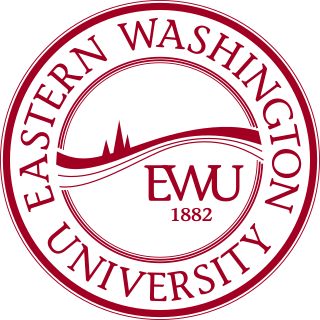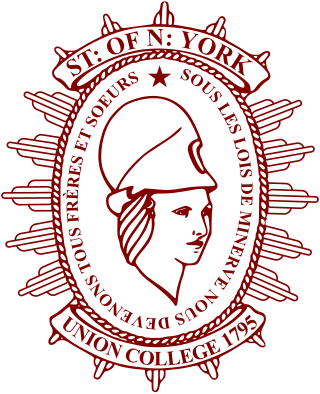
Deer Lodge is a city in and the county seat of Powell County, Montana, United States. The population was 2,938 at the 2020 census.

Eastern Washington University (EWU) is a public university in Cheney, Washington. It also offers programs at a campus in EWU Spokane at the Riverpoint Campus and other campus locations throughout the state.

Union College is a private liberal arts college in Schenectady, New York, United States. Founded in 1795, it was the first institution of higher learning chartered by the New York State Board of Regents, and second in the state of New York, after Columbia College. In the 19th century, it became known as the "Mother of Fraternities", as three of the earliest Greek letter societies were established there. Union began enrolling women in 1970, after 175 years as an all-male institution. The college offers a liberal arts curriculum across 21 academic departments, as well as opportunities for interdepartmental majors and self-designed organizing theme majors. The school offers ABET-accredited undergraduate degrees in computer engineering, bioengineering, electrical engineering, and mechanical engineering. About 60% of Union students engage in some form of international study or study abroad.

Montana Technological University, popularly known as Montana Tech, is a public university in Butte, Montana. Founded in 1900 as the Montana State School of Mines, the university became affiliated with the University of Montana in 1994. After undergoing several name changes, in 2017 the Montana University System Board of Regents voted to designate Montana Tech as part of Special Focus Four-Year Universities, the only such designation in the Montana University System. To recognize this new designation and the greater independence with it, the name was officially changed in 2018 from Montana Tech of the University of Montana to Montana Technological University. Montana Tech's focus is on engineering, applied and health science.

Cornell College is a private liberal arts college in Mount Vernon, Iowa. Originally the Iowa Conference Seminary, the school was founded in 1853 by George Bryant Bowman. Four years later, in 1857, the name was changed to Cornell College, in honor of iron tycoon William Wesley Cornell.

Montana State University (MSU) is a public land-grant research university in Bozeman, Montana. It enrolls more students than any other college or university in the state. MSU offers baccalaureate degrees in 60 fields, master's degrees in 68 fields, and doctoral degrees in 35 fields through its nine colleges. More than 16,700 students attended MSU in the fall 2019, taught by 796 full-time and 547 part-time faculty. In the Carnegie Classification, MSU is placed among "R1: Doctoral Universities – Very high research activity", one of only two universities to receive this distinction with a "very high undergraduate" enrollment profile. The university had research expenditures of $129.6 million in 2017.

Virginia Intermont College (VI) was a private college in Bristol, Virginia. Founded in 1884 to create additional educational opportunities for women, the college had been coeducational since 1972. It experienced significant financial difficulties during the last years of its existence, was denied accreditation in 2013, and announced its closure on May 20, 2014.

Union Presbyterian Seminary is a Presbyterian seminary in Richmond, Virginia, and Charlotte, North Carolina, offering graduate theological education in multiple modalities: in-person, hybrid, and online.

The University of the District of Columbia (UDC) is a public historically black land-grant university in Washington, D.C. It was established in 1851 and is the only public university in the city. UDC is a member school of the Thurgood Marshall College Fund. The full university system offers workforce and certificate programs in addition to Associate, Baccalaureate, Master's, professional, and Doctoral degrees. The university's academic schools and programs include the UDC Community College, College of Arts and Sciences, School of Engineering and Applied Sciences, School of Business and Public Administration, Colleges of Agriculture, Urban Sustainability & Environmental Sciences, and David A. Clarke School of Law.

Kents Hill School is a co-educational, independent college-preparatory school for boarding and day students. Kents Hill is located in Kents Hill, Maine, 12 miles west of the state capital of Augusta. It is the 30th oldest boarding school in the United States and one of the oldest continuously operating co-educational college preparatory schools. One of the three oldest Methodist academies in the United States, the school is now a member of the Association of Independent Schools in New England (AISNE) and accredited by the New England Association of Schools and Colleges (NEASC).

Rocky Mountain College is a private college in Billings, Montana. It offers 50 liberal arts and professional majors in 24 undergraduate disciplines. As of 2013, the college had 1,069 enrolled students. RMC is affiliated with the United Methodist Church, the Presbyterian Church (USA), and the United Church of Christ.

The Beaverhead–Deerlodge National Forest is the largest of the National Forests in Montana, United States. Covering 3.36 million acres (13,600 km2), the forest is broken into nine separate sections and stretches across eight counties in the southwestern area of the state. President Theodore Roosevelt named the two forests in 1908 and they were merged in 1996. Forest headquarters are located in Dillon, Montana. In Roosevelt's original legislation, the Deerlodge National Forest was called the Big Hole Forest Reserve. He created this reserve because the Anaconda Copper Mining Company, based in Butte, Montana, had begun to clearcut the upper Big Hole River watershed. The subsequent erosion, exacerbated by smoke pollution from the Anaconda smelter, was devastating the region. Ranchers and conservationists alike complained to Roosevelt, who made several trips to the area. (Munday 2001)

David R. Francis Quadrangle is the historical center of the University of Missouri in Columbia, Missouri. Known as The Quad, it is the oldest part of Red Campus and adjacent to Downtown Columbia at the south end of the Avenue of the Columns. At its center are six Ionic columns, all that remains of the original university building Academic Hall. Twelve buildings front the modern quadrangle including the domed main administration building Jesse Hall, the tallest building in Columbia. The Quad was designed and constructed by architect Morris Frederick Bell and his assistant William Lincoln Garver. It is named after Missouri governor David R. Francis. Eighteen structures, including the entire quad and most of Red Campus are listed as the Francis Quadrangle National Historic District. An obelisk, the original tombstone of Thomas Jefferson, stands in front of the Chancellor's Residence. It was gifted to the University by Jefferson's descendants in recognition of Missouri's ties to Virginia. In front of Jesse Hall stand markers honoring university president Richard Henry Jesse and Missouri governor David R. Francis. Nearby is another obelisk in memory of Missouri's first U.S. senator David Barton, The Missouri School of Journalism is located at the northeast corner of The Quad, comprising Walter Williams Hall, Neff Hall, Gannet Hall, along with the Reynolds Journalism Institute. To the west, Switzler Hall is the oldest academic building on campus, though the Residence on the Quad, home of the chancellor, is the oldest building overall. The University of Missouri College of Engineering completes the west side. Pickard Hall is currently closed due to radiation contamination from turn of the century experiments. Swallow Hall was recently renovated and houses the Departments of Anthropology, Visual Studies and Ancient Mediterranean Studies.

James R. Reid was a Canadian American who was a Presbyterian minister. He served as the second president of Montana State University from 1894 to 1904.

Link & Haire was a prolific architectural firm in Montana, formally established on January 1, 1906. It designed a number of buildings that are listed on the National Register of Historic Places.

The History of Louisiana Tech University began when the Industrial Institute and College of Louisiana was founded in Ruston, Louisiana in 1894. The institute was founded to develop an industrial economy in the state of Louisiana. Four years later, the school was renamed the Louisiana Industrial Institute when Louisiana adopted the Constitution of 1898. When the Constitution of 1921 was passed, the school changed its name again to Louisiana Polytechnic Institute to reflect the school's evolution from a trade school into a larger and broader technical institute. Although the university was informally called Louisiana Tech for about five decades after the 1921 name change, it was not until 1970 when Louisiana Polytechnic Institute officially changed its name to Louisiana Tech University. Over the course of its history, the school grew from a small industrial institute with one building to a university with five colleges and an enrollment of around 11,800 students.

The history of Baldwin Wallace University dates back to 1828, when co-founder John Baldwin settled in present-day Berea, Ohio. His founding eventually established Baldwin–Wallace College. This founding of present-day Baldwin Wallace University began when Baldwin Institute was established in 1845. With the help of James Wallace, Baldwin Institute began offering college courses. Eventually, in 1863, a resolution established a separate school from Baldwin University to serve the booming local German population called German Wallace College. Originally part of Baldwin Institute, German Wallace College was established just down the road. As a result of financial hardships the schools merged in 1913, forming Baldwin-Wallace College. In 2010, several buildings were added to the National Register of Historic Places combining the former Lyceum Village Square and German Wallace College to form the BW South Campus Historic District. In 2012, Baldwin-Wallace College became Baldwin Wallace University and established the BW North Campus Historic District. The Conservatory is home to the Baldwin-Wallace Bach Festival, the oldest collegiate Bach Festival and the second-oldest Bach festival in the United States honoring Johann Sebastian Bach.

Scotland's Rural College is a public land based research institution focused on agriculture and life sciences. Its history stretches back to 1899 with the establishment of the West of Scotland Agricultural College and its current organisation came into being through a merger of smaller institutions.
Augustus Meader Ryon (1862–1949) was an American mining engineer who served as the founding president of Montana State University. He also has the distinction of having the shortest tenure of any president of the university, only a single year.

Chicora College, also called Chicora College for Women, was a Presbyterian women's college in Greenville and Columbia, South Carolina. It operated from 1893 to 1930 when it merged with Queens College in Charlotte, North Carolina.























